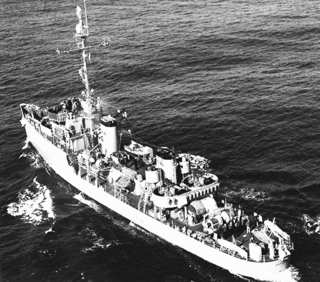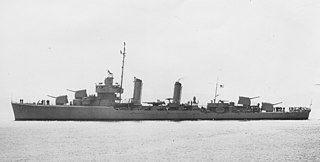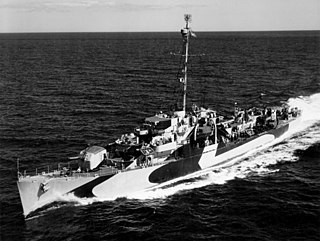
USS Thompson (DD-627) was first a Gleaves-class destroyer, then became an Ellyson-class destroyer minesweeper. She was the second Navy ship named "Thompson", and the first named in honor of Robert M. Thompson.

USS Duncan (DD-874) was a Gearing-class destroyer of the United States Navy, the third named for Captain Silas Duncan USN (1788–1834). The ship was laid down by the Consolidated Steel Corporation at Orange, Texas on 22 May 1944, launched on 27 October 1944 by Mrs. D. C. Thayer and commissioned on 25 February 1945. The ship was sunk in 1980.

The second USS Hamilton (DD–141) was a Wickes-class destroyer in the United States Navy following World War I, later reclassified DMS-18 for service in World War II.

USS Hogan (DD-178/DMS-6) was a Wickes-class destroyer in the United States Navy during World War II.

USS Stembel (DD-644) was a Fletcher-class destroyer in service with the United States Navy from 1942 to 1947 and from 1951 to 1958. In 1961, she was transferred to Argentina where she served as ARA Rosales (D-22). She was scrapped in 1982.

USS Leonard F. Mason (DD-852) was a Gearing-class destroyer in the United States Navy, She was named for Private First Class Leonard F. Mason USMC (1920–1944), who was posthumously awarded the Medal of Honor for his heroism during the Battle of Guam.

USS O'Brien (DD-725), an Allen M. Sumner-class destroyer, was the fourth ship of the United States Navy to be named after Captain Jeremiah O'Brien and his five brothers, Gideon, John, William, Dennis and Joseph, who captured HMS Margaretta on 12 June 1775 during the American Revolution.

USS John W. Thomason (DD-760), an Allen M. Sumner-class destroyer, is the only ship of the United States Navy to be named for John William Thomason, Jr., a USMC officer who was awarded the Navy Cross for bravery during World War I.

USS Defense (AM-317) was an Auk-class minesweeper acquired by the United States Navy for the dangerous task of removing mines from minefields laid in the water to prevent ships from passing.

USS Doyle (DD-494/DMS-34), was a Gleaves-class destroyer of the United States Navy.

USS Carmick (DD-493/DMS-33), a Gleaves-class destroyer, was the only ship of the United States Navy to be named for Major Daniel Carmick (1772–1816), an officer in the United States Marine Corps who served during the Quasi-War with France and during the War of 1812.

USS Rooks (DD-804) was a Fletcher-class destroyer of the United States Navy, named for Captain Albert H. Rooks (1891–1942) who was posthumously awarded the Medal of Honor after the Battle of Sunda Strait.

USS Herbert J. Thomas (DD-833) was a Gearing-class destroyer of the United States Navy.

USS Hamner (DD-718) was a Gearing-class destroyer in the United States Navy during the Korean War and the Vietnam War. She was named for Henry R. Hamner.

USS Ernest G. Small (DD/DDR-838) was a Gearing-class destroyer of the United States Navy, named for Rear Admiral Ernest G. Small (1888–1944).
USS Swift (AM-122) was an Auk-class minesweeper acquired by the United States Navy for the dangerous task of removing mines from minefields laid in the water to prevent ships from passing.
USS Spear (AM-322) was an Auk-class minesweeper acquired by the United States Navy for the dangerous task of removing mines from minefields laid in the water to prevent ships from passing.

USS Speed (AM-116) was an Auk-class minesweeper acquired by the United States Navy for the dangerous task of removing mines from minefields laid in the water to prevent ships from passing.

USS Silverstein (DE-534) was a John C. Butler-class destroyer escort in service with the United States Navy from 1944 to 1947 and from 1951 to 1958. She was sold for scrapping in 1973.

USS Lewis (DE-535) was a John C. Butler-class destroyer escort in service with the United States Navy from 1944 to 1946 and from 1952 to 1960. She was finally sunk as a target in 1966.



















